St James Clerkenwell Monuments
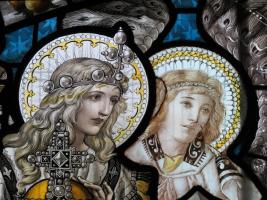
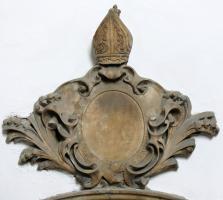
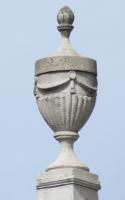
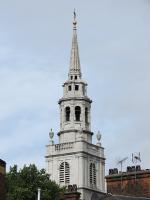
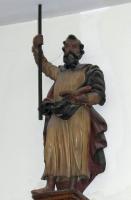
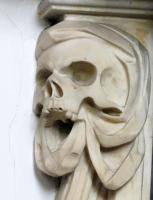
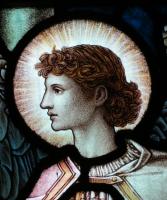
St James Clerkenwell stands on the site of the ancient Benedictine Nunnery of St Mary.
The Gentleman s Magazine for 1787 includes a letter noting the demise of the ancient Church:
That ancient fabric, the parish church of St James, Clerkenwell, being in so ruinous a condition
that it will probably shortly be taken down, when the many venerable remnants of antiquity now in that
dilapidated monastery will in all likelihood be for ever lost.
Of interest here, the letter also noted a few monuments, including to one a Charles Sibbald, d.1645,
a plain stone monument to Elizabeth Barkley, with an effigy, the monument to Sir William Weston,
and his lead coffin, containing a skeleton with a quantity of a dark-coloured mucilaginous substance
between the thighs and lower parts of the body of an unctuous feel, but quite inodorous .
The current Church of St James Clerkenwell was put up by the rather less well known architect James Carr
after 1788, following a report to the House of Commons in 1787, where Mr Carr was a chief witness
that the structure of the old Church was unsafe and it would need rebuilding. It is of brick and Portland stone,
with the chief feature being the square-sided stone tower with a steeple. But this does not date from the 1788
rebuilding, but is a reproduction by W. P. Griffith in the middle of the 19th Century.
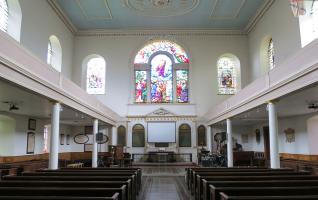
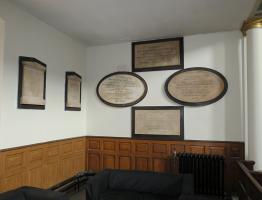
St James Clerkenwell, view of interior and a corner with monuments.
Inside, the Church is rectangular, tall, and bright, with its arched windows, galleries and walls in white,
and delicate duck-egg blue ceiling with plasterwork. The various monuments we have come to see are displayed
around the walls on the ground floor. Apparently there survives in the crypt an effigy of a woman thought
to be Elizabeth Berkeley, d.1585, much defaced. Nor did I see the effigy in a shroud of
Sir William Weston, Prior of St John s, d.1540. So we start with the still grand monument to
Elizabeth Drury, of the mid-19th Century, and proceed in date order from there:
17th Century Monuments:
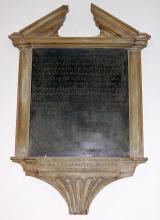 Monument to William Wood, d.1691, archer extraordinaire.
Monument to William Wood, d.1691, archer extraordinaire.
18th Century Monuments:
There are half a dozen, four from early in the Century, and two from the end.
- Elizabeth (Holder) Partridge, d.1702, with a Latin inscription. A cartouche monument,
thus with a central, broadly oval panel, domed in the centre, surrounded by a broad carved border of scrolls,
knotted and hanging drapery, and cherubs. The convention is that the drapes are tied at the upper corners,
usually (though not here) originating from the centre, and hanging down on the sides. Poking out form under
the drapes are two winged cherub heads, which is a frequent device, and the drapes then hang more flatly
to form a lower border to the monument, with a fringe. Up at the top, on top of the central scrolls,
is a head and shoulders bust of Mrs Partridge, in a roundel, surrounded with flowers, and with on each side
a naked cherub; one holding up the portrait, the other snivelling into a handkerchief, and asymmetrically arranged.
The portrait shows the deceased as a fairly youthful woman, with smooth neck and chest, curly hair swept back
to heighten the forehead, and with loose curls hanging down over one shoulder. She wears a bulky dress,
and rests her head sideways on one hand, her eyes closed in repose. Her other hand holds open a small book,
with the French word Reve [Dream] upon it. At the very base of the monument is a bracket carved as a deaths-head,
or winged skull, lacking its lower jaw which is typical. The treatment of the wings is very good.
A note below says that the monument was taken out of the vault of the Church in 1838.
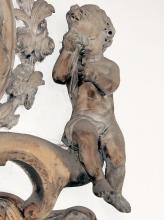
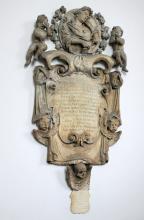
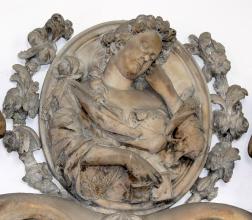
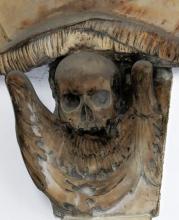
Elizabeth Partridge, d.1702, portrait, and details.
- Thomas Crosse, d.1712, listing his positions and family. Grand monument with side pilasters,
and a great broken, curved pediment with a cartouche of arms and festoons within it. In front of each side
is a full bust on a plinth, supported on a scroll. To the left, as we look at the monument, is Thomas Crosse,
with full periwig of flowing curls, and a plump, well-satisfied face; he wears a fringed cravat or neckerchief
above a thick robe, in the combination of 18th Century and Roman Senator styles that seems to work so
well on portrait sculpture of the time. To the right is the bust of Dorothy (Willymott), his wife, shown
as a youthful woman of Valkyrie proportions, with wavy hair, and a vaguely Classical garment with a bit of a frill
at the top. The sculpture has been attributed to the great sculptor Roubiliac, but the date is early
the monument was put up in 1722 whereas Roubiliac is not known to have done work in England until he settled
in the country in 1730.
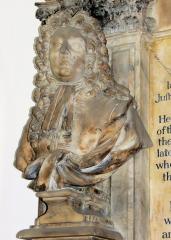
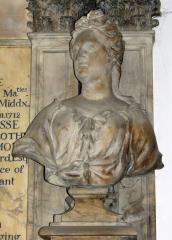
Thomas Crosse, d.1712, and wife Dorothy (Willymott).
- Henry Penton, d.1714, with a Latin inscription. One of the tall monuments with an obelisk
on top which found much favour in the 18th Century, but very unlike the usual style(see this page),
which is to have the obelisk essentially cut as a dark backing panel, with whatever sculptural adornment
coat of arms, pot, girl and pot - placed upon it. Here the obelisk is more like a churchyard obelisk,
thus a more solid structure, in white marble, here decorated over its surface with finely carved flowers,
and a ribbon. At the top it is treated as a pedestal, with upon it a ball or perhaps seed with a small rooted plant
arising from it. Really unusual. To the sides of the obelisk are two conch-shaped lanterns.
Then a shelf across the monument, and the lower portion containing the inscribed panel as is more conventional.
Less conventional, to the sides of this are scrolly sidepieces, with outward-facing skulls at the tops,
and the spaces between sides and centre are in black marble. There is another, broader shelf below,
and underneath this, a carved and painted coat of arms, and a supporting bracket with leaves; smaller leafy brackets
support the ends of the shelf. What a splendid and unusual thing.
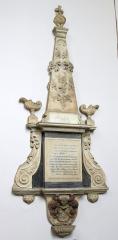
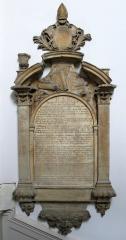 Obelisk monument to Henry Penton, and Robert Hartshorne's panel to Gilbert Burnet.
Obelisk monument to Henry Penton, and Robert Hartshorne's panel to Gilbert Burnet.
- Gilbert Burnet, d.1715, theology professor, writer and later Bishop of Salisbury,
with a long inscription in Latin. A most interesting monument. The inscribed panel is under a thin arch,
with tall Corinthian side pilasters, and a curved pediment entirely open at the base to allow a field
within which is carved in low relief a collection of books, scrolls and quill pens of the scholar.
The central portion of the top of the curved pediment is raised up somewhat, and supports a cartouche,
now blank, but presumably once with a painted coat of arms, with scrolling and ferny branches around it,
and a little mitre on top. At the sides of the pediment, one of a pair of small urns survives.
Down at the bottom of the monument, the pilasters rest on gadrooned (corrugated) bases, and there are
carved leafy supports to the sides and centre of the monument, and the signature of the sculptor,
Robert Hartshorne. He was a significant sculptor, who worked for the Stantons and who had Henry Cheere
in his own workshop for a time. I think this is his only work in London. The design, according to information
in the Church, is by Edward Stanton.
- Revd. William Sellon, d.1790, curate and Minister of the Church, and the first burial
in the vault under the Church. A nice oval, with black oval surround, and a plaster ribbon above.
- John Hort, d.1794. Small pale marble panel, slightly curved at top and base,
and with a shield of arms carved in low relief in a central circular depression, an unusual arrangement.
There is a dark backing, and underneath a little shield noting the monument was removed from the vault
of the Church in 1879.
19th Century Monuments:
We have a fair range of early and Victorian panels, including the ubiquitous white-panel-on-black monuments,
which as simply formed Classical pieces with a minimum of carved work, are found the length and breadth of the land.
They include a few pieces signed by the mason-sculptors who made them.
- Revd. James Davies, d.1804, Minister of the Church and Lecturer at St Lawrence Jewry,
and St Stephen s Coleman Street in the City, and his wife Elizabeth, d.1800. An oval, with black oval backing.
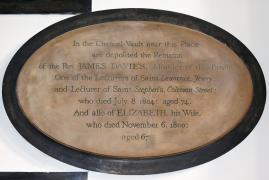
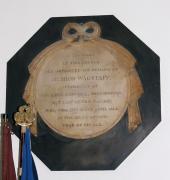
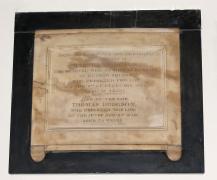
White on black panels, early 19th Century, to Revd. Davies, Wagstaff, and Martha Hodgson.
- James Winfield, d.1807, wife Martha, d.1839, and son John Tonman Winfield, d.1846.
Tall panel with worn inscription, heavy shelf below, and heavy pediment above without a rim.
The only carved ornament is under the pediment, a stylised repeating leaf pattern. On a black backing.
- Joseph Hale, d.1813, and wife Martha Hale, d.1832, plain brecciated brownish marble panel
with bevelled edges.
- Revd. Henry Foster, Minister of the Church, d.1814, with the dark quote Brethren.
The time is short . Plain panel with a black backing, rectangular.
- Mico Wagstaff, d.1814, recording his trade as an Ironmonger. Circular panel,
with carved drapery tied at the top in a sideways figure eight, and hanging around the edges
and sides of the circle; nicely enough done, but without much effect of gravity.
On a black octagonal backing. An unusual composition and treatment.
- Thomas Sherwood, d.1821. In shape, this is a typical small monument of the time,
with a Classical or tomb-chest end design, with side pilasters, segmental (curved) pediment above with acroteria,
blocky supports below and a central apron. But it is far superior to the normal white-on-black panels
of this type and time. Each of the side pilasters bears upon it an upturned torch in low relief,
symbolic of the extinction of life. The pot carved in the pediment, also in low relief, is delicate and subtle,
with elegant curves, repeating patterns and leafy handles. And at the base is a small shield of arms,
blank now, with behind it a wreath, crossed palm fronds and ribbons. The monument is similar enough in composition to that
of Thomas Greatrix (see pictures of them both below) that it suggests that J. Hollis of Goswell Road also made this one.
- Martha Hodgson, d.1823, and husband Thomas Hodgson, d.1840. Tomb chest end of the simplest kind,
with frame around the central panel and supported on small rounded feet, with a rectangular black backing
and no ornament.
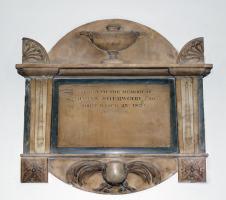
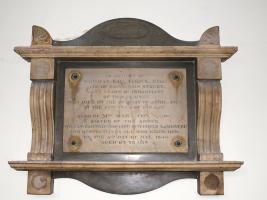
Sherwood and Greatrex monuments, 1820s, the latter by local mason J. Hollis.
- Thomas Greatrex, d.1824, and his sister Mrs Mary Fox, d.1840. Rather a nice monument,
with a black border round the central panel, and around this, a pinkish alabaster frame of upper and lower shelf,
and curly, fluted sidepieces with blocks at the top. Above the upper shelf and below the lower,
more black backing cut to a wavy shape, indicative of a pediment above and apron below.
There are acroteria carved with the familiar anemone patterns. There seem to have been various small
carved attachments to the surround, but all of these have been lost. By the stone mason J. Hollis, of Goswell Road,
which leads off Clerkenwell, so lying a few minutes walk from the Church.
- William Abud, d.1827, and wife Elizabeth Abud, d.1842, and son William Taylor Abud, d.1848.
Tall panel with white surround, consisting of pilasters to the sides, pediment at the top with acroteria,
and thick shelf and small supports at the base. The pediment contains a carving of a snake swallowing its tail,
a rather pagan emblem of eternity.
- William Clare, d.1838, and wife Sarah Clare, d.1845. Tall, solid panel with upper entablature
and pediment. The pediment has acroteria but is otherwise blank, while the entablature bears three carved wreaths.
At the base, a blocky shelf with carved upon it crossed palm leaves, and there are two moulded supports.
On a black shaped backing and signed by the stone mason, Sanders of New Road, Fitzroy Square.
- Revd. Thomas Sheppard, d.1839, and his wife Frances, d.1834. Plain panel with rectangular surround
in black.
- William Adkins, d.1822, Many years Governor of the House of Correction, Cold Bath Fields
a splendid epitaph. Erected by his son, James Adkins, in 1851. Very similar to the Winfield panel in design.
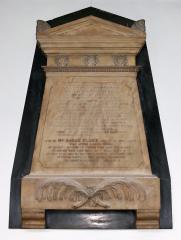
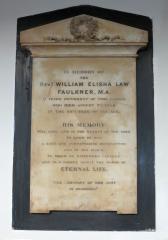 Tall panels to Clare, by Sanders of New Rd, and Faulkner, by J.S. Farley of Goswell Rd.
Tall panels to Clare, by Sanders of New Rd, and Faulkner, by J.S. Farley of Goswell Rd.
- Revd. William Elisha Law Faulkner, d.1856, incumbent of the Church for 17 years,
with a brief eulogy. Tall panel with upper pediment, without rims but bearing upon it a carved wreath of flowers
tied with a ribbon. On a shaped black backing, signed by the stone mason, J. S. Farley, 12 Goswell Road.
- Mrs Martha Greenfield, d.1867, Schoolmistress of the Clerkenwell Parochial Charity Schools
for 34 years, erected by past and present scholars. With upper shelf and pediment and little acroteria,
on a shaped backing of grey marble with pale inclusions. Made by the stone mason J. S. Farley,
now moved to 81 or 181 Goswell Road.
- Edward Greenfield, d.1881, long-time Master of Clerkenwell Parochial Schools,
and Clerk of the Church. Identical to the panel for his wife, by but the grey marble could not quite be matched,
and has here attractive dark streaks.
20th Century Monument:
- William Robson, erected 1906, churchwarden, promoter of the Clerkenwell Public Library &c &c,
a fine panel of the period, with a splendid font, and surrounded by a border of gold mosaic
with green edging and white quatrefoils at the corners: just six mosaic pieces wide but extremely effective. It is signed by
C.J. Parker, the Vicar of the time. A nice way to end the historical sequence of monuments in the Church.
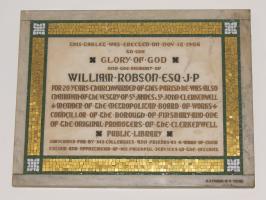 William Robson tablet with mosaic border, 1906.
William Robson tablet with mosaic border, 1906.
Also in the Church:
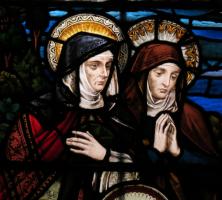
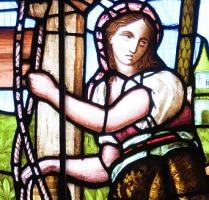
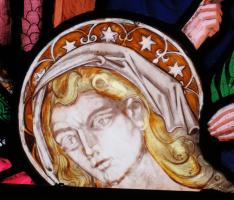
Stained glass in St James Clerkenwell.
With many thanks to the Church authorities for permission to show pictures of the monuments inside; their website is
http://www.jc-church.org/welcome/.
Top of page
Churches in London // City Churches // Introduction to church monuments // London sculpture
Home
Visits to this page from 20 Jan 2016: 6,075









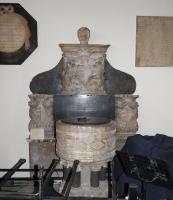
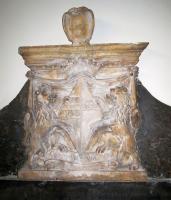
 Monument to William Wood, d.1691, archer extraordinaire.
Monument to William Wood, d.1691, archer extraordinaire.

 Obelisk monument to Henry Penton, and Robert Hartshorne's panel to Gilbert Burnet.
Obelisk monument to Henry Penton, and Robert Hartshorne's panel to Gilbert Burnet.






 Tall panels to Clare, by Sanders of New Rd, and Faulkner, by J.S. Farley of Goswell Rd.
Tall panels to Clare, by Sanders of New Rd, and Faulkner, by J.S. Farley of Goswell Rd.
 William Robson tablet with mosaic border, 1906.
William Robson tablet with mosaic border, 1906.


